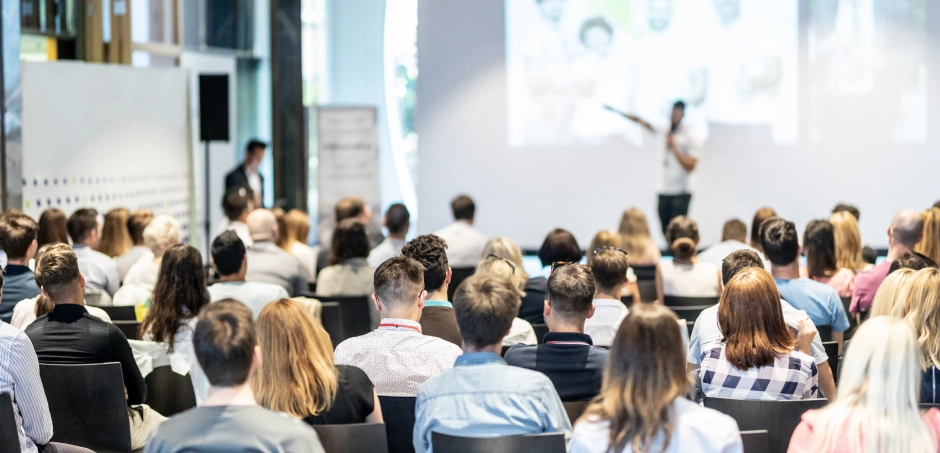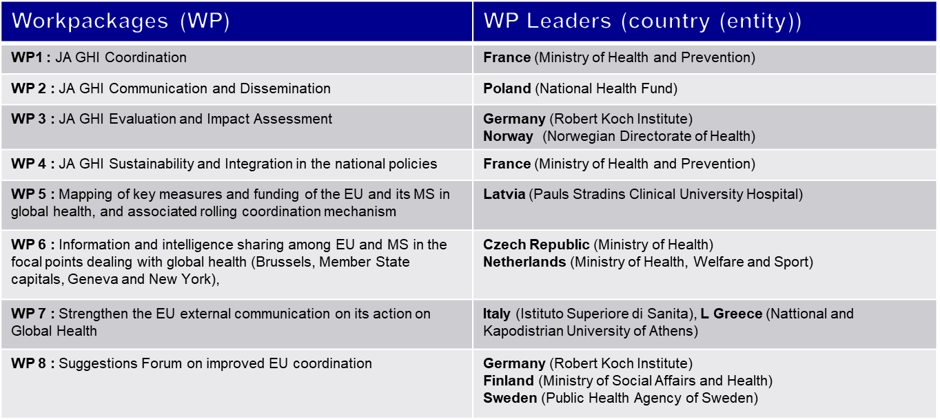EU JA GHI Kick-Off Meeting
The Kick-Off meeting of the EU JA GHI took place on October 13th and 14th 2023 in Berlin, back to back with the World Health Summit 2023 (www.worldhealthsummit.org).
The objectives of the meeting were:
· Align understanding of consortium colleagues of the JA GHI strategy;
· Clarify for consortium colleagues, what we will do over the next weeks and two years;
· Ensure that consortium colleagues are aware of the administrative rules, contractual obligations and the legally binding work programme;
· Grow joint knowledge about central documents, forums and actors in global health;
· Getting to know each other to make working together more effective and fun.
In order to reach these aims, the meeting consisted of a mix of plenary presentations, group work and social interactions. The agenda of the meeting is included in this report.
Representatives of 15 EU member states, as well as colleagues from Africa CDC, DG INTPA, DG SANTE, HaDEA and Norway participated in person. The list of participants is annexed to this report. Additional participants from EU member states (including Belgium, Croatia, Poland, Sweden, Italy, Romania), from Ukraine and from EU institutions (DG SANTE, EEAS, HaDEA) followed the proceedings online.
The meeting started with a welcome by Björn Kümmel representing the German Federal Ministry of Health, the host of the kick-off meeting. Mr. Kümmel highlighted that the EU can make a difference in troubled times. The role of EU as negotiator in the development of the Pandemic Agreement is an example of the EU’s influence in the global health arena.
In their short welcome remarks, Francisco Perez Canado (DG SANTE) expressed his conviction that the JA is the engine of the EU’s Global Health Strategy, and Florina Telea (HaDEA) called the JA the flagship in the field of global health.
Participants next got together in 3-person groups to informally introduce themselves to each other and exchange on their expectations for the kick-off meeting. The expectations expressed most often were: 1) learning about the JA (expressed 10x), 2) clarity about the JA (9x), 3) information sharing (8x), and 4) clarifying concrete next steps (7x). Participants also expressed their expectations for the JA to generate evidence for EU global health policy, to enhance the influence of the EU Strategy on global health, to develop a strong collaboration platform, to build a good “Team Europe”, and to promote “health in all policies” and capture global health activities from all ministries and the Commission DGs and services.
The meeting next moved to introductory presentations. Francisco Perez Canado (DG SANTE) spoke about the EU Global Health Strategy. He said that global health has nowadays a geopolitical dimension. While pandemic preparedness and universal health coverage are the two pillars of the EU Global Health Strategy, there are many issues that one needs to focus on.
Three important priority topical areas are:
1) root causes of health to be better addressed, focus on women, children and disadvantaged groups (social, economic, climate, environmental), health promotion, disease prevention, primary health care, public health;
2) digitalization, work force imbalances, innovation/research;
3) better combat health threats, EU’s own preparedness, access to countermeasures for low/middle income countries, Pandemic Agreement with One Health strengthening, IHR strengthening, robust global multilateral surveillance network.
Francisco Perez Canado stressed the importance of the “health in all policies” approach, and of the need for the different branches in our national and EU administrations to work together (climate, trade, humanitarian aid, research, …). He also emphasised the need for a robust set of partnerships across the world; while in the past “we were telling partners what to do”, a new approach of co-ownership and shared responsibility is important. He added that financing global health activities is challenging because of budget limitations; therefore, the focus should be on innovation, finding new ways of financing, and teaming up with other partners. Last but not least, the EU Global Health Strategy will have a robust monitoring and evaluation system; monitoring and evaluation is foreseen every three years.
Miriam Brewka Pino (EEAS) gave a short presentation on developments regarding EC’s IT tools and knowledge exchange platforms. She explained that the existing platform AGORA is not secured enough and limited in its functionalities and that therefore a new system – HIVE – is in preparation, which will include storage and library functions.
Jerome Weinbach (France), the JA coordinator, provided an overview of the JA, followed by 5’ interventions by all the work package leads.
The aim of the first round of break-out sessions was to exchange on and clarify the “strategic core” of the JA GHI and to discuss transversal issues across all work packages. All three break-out groups were asked to address the following questions:
· What are key aims and messages?
· What are key actors/stakeholders and their roles (e.g. EU, non-EU, academics, NGOs, citizen, media, private sector (non for profit and for profit), international organisations, …)?
· Who should be appointed in the JA GHI High Level Panel (names, roles)?
· Which relevant EU and international developments, initiatives, events and processes do we expect?
· What are the “boundaries” of the mapping exercise? What challenges do we expect with the mapping?
· What do we expect from the IT tools? What experience do we have with such tools?
· What are other issues to be considered (e.g. organising the planned specific dissemination events)?
In the reporting by the three break-out groups, the following points were highlighted:
· Global health action is value-based EU action.
· Not all EU member states have capacities to have their own global health strategy.
· Important global health forums are: WHA, WHS, G7, G20, EU + Africa and EU + Latin America consultations, OECD ministerial meeting, also COP.
· Bring in industry/private sector, as they are serious donors and provide services.
· Also think about ministries of environment, agriculture, transportation, housing, etc. because a healthy environment is a precondition of health.
· Global health communication actions should be focused on citizens and their representatives; EU citizens need to accept the EU’s global health work.
· Building trust is important for making the Strategy work, not just between EC and member states but also between member states and internationally.
· IT tools: How do the different IT tools interact? Where do the data come from (existing data bases, e.g. OECD DAC reporting)? Are they adapted to our needs for maximising the EU global health impact?
· Mapping: Scope of the mapping still to be agreed; dependent on definition of global health / international health; even nationally mapping is difficult.
· There are very different types of GH activities: high level strategic action and political initiatives, operational/project level. We need more convergence at strategic level, more divergence at the project level.
The aim of the second round of break-out sessions was to exchange on and clarify modes of operation, role of contractual contributors, responsibilities, work plan and concrete next steps for the technical work packages 5 to 8 as well as discuss alignment of the different work packages (in particular the connections between work packages 5, 6 and 8). The four break-out groups were asked to address the following points:
- Frequency and modus of regular exchange
- Responsibilities
- Review and further development of work plan
- Brainstorming on concrete work package activities
- Concrete next steps to be presented in the plenary session
- How would work packages interact with work package 3 on evaluation? How would they set targets on the indicators? Who can work packages choose as point of contact for work package 3?
- How would work packages interact with work packages 2 and 7? How to choose the right forums for disseminating the JA’s work? How would they choose the most effective audience that would listen and act in favour of the EU Global Health Strategy and its JA?
Following the detailed discussions in the break-out session, participants moved back to plenary presentations. Bernd Appelt (DG INTPA) recalled in his remarks that the EU has had a Global Health Strategy since 2010, stressed that monitoring global health action is a formidable challenge, and made suggestions for defining what constitutes global health action in the sense of the EU’s global health strategy. His speaking points are annexed to this report.
Wessam Mankoula (Africa CDC) added an EU-external perspective to the meeting. He stressed in his presentation that many COVID-19 lessons are not yet learned, and that global health action requires respectful partnerships, in which consultation precedes decision-making on activities and programmes. He also presented the programmatic priorities and enablers for Africa CDC’s 2023-2027 Strategic Plan. His presentation is annexed to this report.
In his remarks, Christophe Guilhou (Sustainable Development Director, MFA France) reminded participants of the new French Global Health Strategy that was launched just one day before the kick-off meeting. He also stressed the importance of strengthening coordination mechanisms and conversation channels, not just within the EU but also with partners globally. Christophe Guilhou’s speech is annexed to this report.
Before closing the meeting, Massimo Fagnini (EC project officer, HaDEA) introduced all consortium members to the administrative rules and regulations to be followed in implementing the JA. His presentation is annexed to this report.






